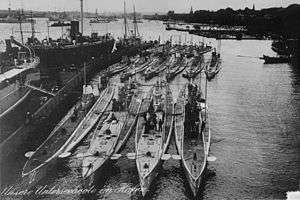SM U-18
 SM U-18 (second row, second from the right) | |
| History | |
|---|---|
| Name: | U-18 |
| Ordered: | May 6, 1910 |
| Builder: | Kaiserliche Werft Danzig |
| Cost: | 2,333,000 Goldmark |
| Laid down: | 27 October 1910 |
| Launched: | 25 April 1912 |
| Commissioned: | 17 November 1912 |
| General characteristics | |
| Class and type: | German Type U 17 submarine |
| Displacement: |
|
| Length: | 62.35 m (204 ft 7 in) |
| Beam: | 6 m (19 ft 8 in) |
| Height: | 7.30 m (23 ft 11 in) |
| Draught: | 3.40 m (11 ft 2 in) |
| Propulsion: | |
| Speed: |
|
| Range: |
|
| Test depth: | 50 m (164 ft 1 in) |
| Boats & landing craft carried: | 1 dingi |
| Complement: | 4 officers, 25 men |
| Armament: | 4 × 45 cm (17.7 in) torpedo tubes (2 each bow and stern) with 6 torpedoes |
| Service record | |
| Part of: |
|
| Commanders: |
|
| Operations: | 3 patrols |
| Victories: | None |
SM U-18[Note 1] was one of 329 submarines serving in the Imperial German Navy in World War I. U-18 engaged in the commerce warfare in the First Battle of the Atlantic.
Service history
Launched in October 1914, she was commanded by Kaptlt. von Hennig.[2] On her third mission, on 23 November U-18 penetrated the fleet anchorage of Scapa Flow via Hoxa Sound, following a steamer through the boom and entering the anchorage with little difficulty. However, the fleet was absent, being dispersed in anchorages on the west coast of Scotland and Ireland. As U-18 was making her way back out through Hoxa Sound to the open sea, her periscope was spotted by a guard boat. The trawler Dorothy Gray altered course and rammed the periscope, rendering it unserviceable. U-18 then suffered a failure of her diving plane motor and the boat became unable to maintain her depth, at one point even impacting the seabed. She was rammed a second time by Dorothy Gray and eventually, her captain was forced to surface and scuttle his command just outside the Hoxa Gate, and all crew members, except one, were picked up by British boats.[3][4] 58°41′N 02°55′W / 58.683°N 2.917°W. One man died and 22 were captured.[5]
The wreck lies 75 m (246 ft) below the surface just outside the Hoxa Gate, at 58°41′N 02°55′W / 58.683°N 2.917°WCoordinates: 58°41′N 02°55′W / 58.683°N 2.917°W.[6]
References
Notes
- ↑ "SM" stands for "Seiner Majestät" (English: His Majesty's) and combined with the U for Unterseeboot would be translated as His Majesty's Submarine.
Citations
- ↑ Helgason, Guðmundur. "WWI U-boat commanders: Heinrich von Henning". German and Austrian U-boats of World War I - Kaiserliche Marine - Uboat.net. Retrieved 22 December 2014.
- ↑ Koerver, Hans Joachim (2008). Room 40: German Naval Warfare 1914-1918.
- ↑ Messimer, Dwight R. (2002). Verschollen: World War I U-boat Losses. Naval Institute Press. pp. 36–40. ISBN 9781557504753.
- ↑ Koerver.
- ↑ Helgason, Guðmundur. "WWI U-boats: U 18". German and Austrian U-boats of World War I - Kaiserliche Marine - Uboat.net.
- ↑ Willmott, H.P. (2009). The Last Century of Sea Power: From Port Arthur to Chanak, 1894-1922. Indiana University Press. p. 376. ISBN 9780253352149.
Bibliography
- Gröner, Erich; Jung, Dieter; Maass, Martin (1991). U-boats and Mine Warfare Vessels. German Warships 1815–1945. 2. Translated by Thomas, Keith; Magowan, Rachel. London: Conway Maritime Press. ISBN 0-85177-593-4.
- Spindler, Arno (1966) [1932]. Der Handelskrieg mit U-Booten. 5 Vols. Berlin: Mittler & Sohn. Vols. 4+5, dealing with 1917+18, are very hard to find: Guildhall Library, London, has them all, also Vol. 1-3 in an English translation: The submarine war against commerce.
- Beesly, Patrick (1982). Room 40: British Naval Intelligence 1914-1918. London: H Hamilton. ISBN 978-0241108642.
- Halpern, Paul G. (1918). A Naval History of World War I. New York: Routledge. ISBN 978-1857284980.
- Roessler, Eberhard (1997). Die Unterseeboote der Kaiserlichen Marine. Bonn: Bernard & Graefe. ISBN 978-3763759637.
- Schroeder, Joachim (2002). Die U-Boote des Kaisers. Bonn: Bernard & Graefe. ISBN 978-3763762354.
- Koerver, Hans Joachim (2008). Room 40: German Naval Warfare 1914-1918. Vol I., The Fleet in Action. Steinbach: LIS Reinisch. ISBN 978-3-902433-76-3.
- Koerver, Hans Joachim (2009). Room 40: German Naval Warfare 1914-1918. Vol II., The Fleet in Being. Steinbach: LIS Reinisch. ISBN 978-3-902433-77-0.
External links
- Helgason, Guðmundur. "WWI U-boats: U 18". German and Austrian U-boats of World War I - Kaiserliche Marine - Uboat.net.
- Room 40: original documents, photos and maps about World War I German submarine warfare and British Room 40 Intelligence from The National Archives, Kew, Richmond, UK.